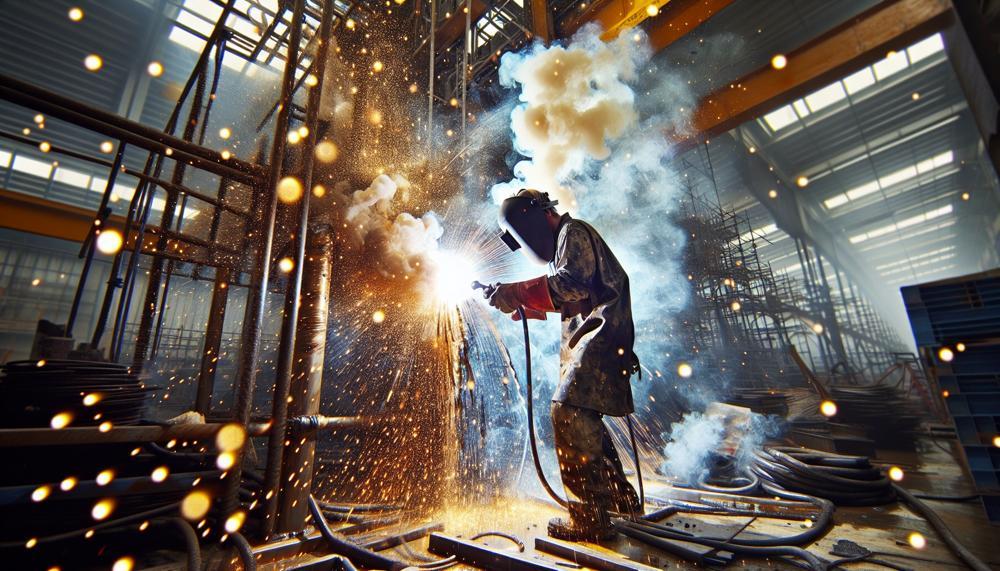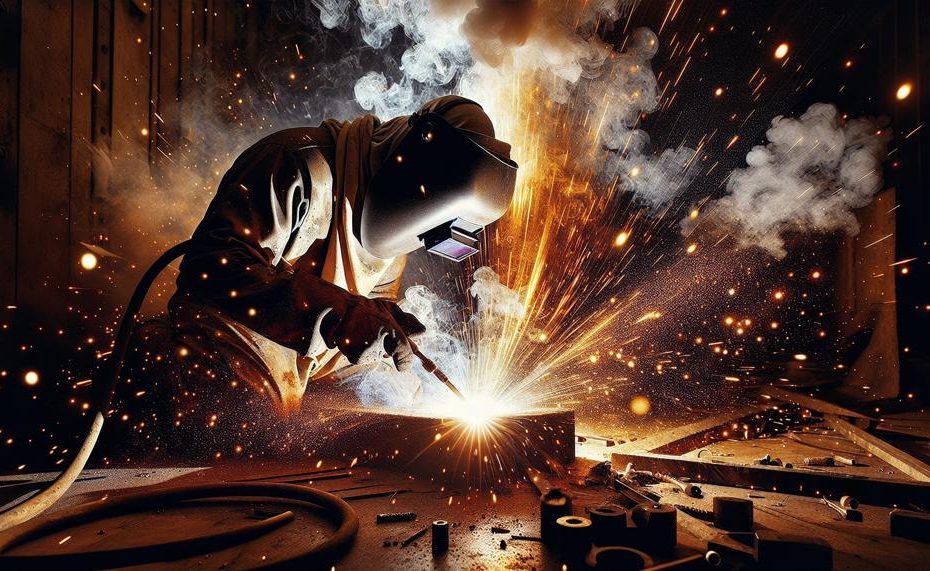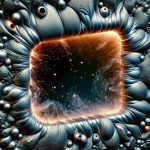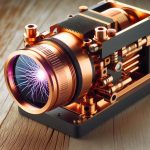Welding, both an art and a science, combines different kinds of metals to make buildings and things that shape our world. Welding spray is an important but often overlooked part of this change process.
Once liquid material drops leave the welding area, they spread glittering specks around the join. Even though welding dust may not seem like a big deal, it has a significant impact on the welding process’s quality, speed, and cleanliness.
Understanding weld splatter isn’t just about how to clean up after it happens; it’s also about understanding the finer points of welding methods, the qualities of materials, and the careful balance between heat and control that makes a welder skilled. In this blog post, we will learn about welding splatter, including what causes it, how it affects things, and the methods welders use to lessen its effects.
You’ll see by the end that controlling spatter isn’t just about cleaning up; it’s an important part of learning how to weld.
Key Takeaways:
- Definition and Significance: Welding spatter is more than just a nuisance; it reflects the complex interplay of factors in the welding process.
- Impact on Welding Quality: Spatter can affect the strength and appearance of the weld, highlighting the need for precise control and technique.
- Minimization Strategies: From adjusting welding parameters to selecting appropriate equipment and materials, there are numerous ways to reduce spatter.
- Beyond Cleanup: Understanding spatter leads to better welding practices, improved efficiency, and enhanced safety.
Join us as we shed light on this spark-filled aspect of welding, offering insights and solutions that promise to enhance your welding projects, whether you’re a seasoned professional or just starting out.
Contents
What Is Spatter In Welding?
Spatter in welding, to put it plainly, refers to the splashes of molten material thrown from the welding arc. Picture the process like splattering paint from a brush – only in this case, it’s hot metal. This isn’t merely a messy annoyance; spatter can mar the surface around a weld, leading to extra cleanup and potentially damaging the aesthetic and structural integrity of the weld.
Not to mention, it can be a downright hazard, flinging hot metal about with abandon.
| Factor | Impact on Spatter | Possible Adjustments |
| Welding Process | Varies by type; MIG tends to spatter more than TIG. | Choose process based on precision needed. |
| Equipment State | Poorly maintained gear increases spatter. | Regular maintenance and checks. |
| Material Cleanliness | Dirt, rust, or oil can heighten spatter levels. | Clean materials thoroughly before welding. |
Spatter’s not just a visual bother; it impacts the weld’s quality. When these droplets solidify on the weld or the surrounding area, they can lead to weaknesses like porosity and lack of fusion. This is no small beer – such defects compromise the strength and durability of the weld, leading to potential failures down the line.
Plus, when spatter adheres to your welding gear, it can clog and damage components, leading to interruptions and unnecessary costs.
Causes of Spatter in Welding
Spatter in welding is akin to hot, flyaway droplets of metal, which can mar the surface, waste materials, and present a burn hazard.
Tackling this nuisance requires a keen understanding of its origins and implementing strategies to minimise its occurrence.
Common Causes and Prevention Measures for Welding Spatter:
| Cause | Description | Prevention |
| Incorrect settings | Misadjusted amperage, voltage, or electrical stick-out. | Refine settings for amperage and voltage, ensuring optimal adjustment. |
| Steep work angle | Welding at an angle over 15 degrees. | Keep the work angle below 15 degrees to reduce spatter. |
| Surface contaminants | Presence of rust, oil, or paint on metal surfaces. | Clean all surfaces meticulously before starting the weld. |
| Mode of metal transfer | Utilising short arc or globular transfer methods. | Switch to spray transfer mode, ideally with at least 83% argon mix. |
| Erratic feeding | Wire feeding speed varies, affecting the arc. | Ensure stable wire feed to maintain consistent amperage. |
| Poor quality consumables | Using wires of subpar quality or inconsistent properties. | Opt for high-quality consumables for reliable performance. |
| Bad shielding gas | Using shielding gas with low argon content or impurities. | Select high-quality shielding gas, rich in argon, for smoother arcs. |
In addition, whilst anti-spatter agents don’t halt spatter, they aid in easier clean-up. Use these agents sparingly to avoid adverse effects on the weld quality.

Understanding these causes and taking preventive steps not only saves time and resources but also ensures the production of cleaner, higher-quality welds.
Effects of Spatter on Weld Quality
Spatter significantly impacts weld quality in several ways, as detailed in the table below:
| Aspect of Weld Quality | Effect of Spatter | Implication |
| Weld Porosity | Spatter can create tiny voids or holes. | Decreases the strength and integrity of the weld, making it prone to cracking. |
| Weld Penetration | Obstructs the weld puddle, leading to inadequate penetration. | Results in weaker welds, susceptible to failure under stress. |
| Weld Appearance | Creates unsightly splatters and drips. | Reduces aesthetic quality, crucial in some industries like automotive. |
| Post-Weld Cleaning | Makes cleaning difficult; might require grinding off. | Increases time and cost in finishing; can alter weld dimensions and compromise strength. |
In essence, spatter is not just a superficial annoyance but a significant factor in determining the durability, appearance, and reliability of a weld. The presence of spatter can mean the difference between a strong, clean, and aesthetically pleasing weld and one that is weak, unsightly, and potentially hazardous.
Impact of Spatter on Welding Equipment
Spatter, those pesky droplets of molten metal flung from the weld pool, might seem small but pack a punch when it comes to the health of welding equipment.
It’s akin to the sea’s salt air; silent but corrosive, slowly wearing down the mightiest of ships. Here’s how spatter plays the villain in the welding world.
| Aspect of Equipment | Impact of Spatter | Consequences |
| Welding Nozzles and Tips | Accumulation of spatter | Leads to blockages, affecting gas flow and weld quality; requires frequent replacements or cleaning, hiking up maintenance costs. |
| Welding Guns and Torches | Build-up on surfaces | Increases wear and tear, necessitating early refurbishment or replacement and hence, elevating operational expenses. |
| Protective Gear and Surrounding Area | Spatter burns and damage | Compromises safety equipment’s integrity and damages other workshop tools or surfaces, adding to the cleanup and repair bill. |
| Workpieces | Adhesion of spatter | Results in unattractive finishes, demanding laborious post-weld cleanup, which lengthens project timelines and costs. |
To combat spatter’s stealth attack, welders must don their armour – cleanliness, precision in technique, and the choice of weaponry (the right welding process, parameters, and materials) are key. Regularly maintaining and inspecting equipment for early signs of wear can fend off the worst of spatter’s sieges.
Additionally, using anti-spatter agents and considering the investment in equipment with spatter-resistant features or coatings can be akin to having a shield in battle, offering an extra layer of protection.
Safety Concerns with Spatter in Welding
In the realm of welding, spatter comprises tiny, fiery droplets of molten metal expelled during the act of welding. This spatter is not merely a nuisance; it is a significant safety hazard, posing risks of burns and fire, particularly in environments rich with flammable substances.
Moreover, the longevity of the equipment and the integrity of the workpiece itself can be compromised through corrosion initiated by these seemingly innocuous metal droplets.
Key Risks Associated with Welding Spatter:
- Burn Injuries: Hot metal spatter can lead to severe burns upon contact with skin or ignition of flammable clothing.
- Fire Hazards: In oil-rich or otherwise combustible environments, spatter can act as a catalyst for disastrous fires or explosions.
- Corrosion: Over time, the residue left by spatter can corrode the workpiece, undermining its structural integrity.
Strategic Measures to Mitigate Spatter Risks:
| Preventive Strategy | Implementation Method | Benefit |
| Material Quality | Use high-grade filler materials and clean metal surfaces. | Reduces incidence of spatter and associated hazards. |
| Optimal Settings | Adjust voltage and amperage according to material and task. | Minimizes spatter generation during welding. |
| Proper Technique | Adopt best practices and correct welding techniques. | Enhances safety and reduces spatter-related defects. |
Embracing these strategies, welders can significantly mitigate the risks posed by spatter. By wielding knowledge as power, they not only safeguard themselves but also ensure the longevity and reliability of their crafted pieces, combating the clandestine adversary that spatter represents.
Techniques to Reduce Spatter in Welding
Reducing spatter in welding is crucial for both safety and the quality of the finished weld. Here’s how to keep those pesky droplets at bay:
- Adjust Voltage and Amperage Settings: Finding the sweet spot in your machine’s settings can greatly diminish spatter. This sweet spot allows for a stable arc and minimal excess metal being expelled.
- Use Anti-Spatter Sprays or Gels: A quick spritz or a dab on the metal surface before you begin can work wonders. These concoctions form a barrier, making it a doddle to wipe away any spatter post-weld.
- Select the Correct Wire: The thickness and type of wire can make a big difference. Opt for a size and variety that complements your material to reduce spatter. Flux-cored wires are particularly good for keeping spatter to a minimum.
- Maintain a Pristine Work Environment: A clean workspace equals a clean weld. Ensure your metal surface is free from contaminants and your welding equipment is in top condition to avoid unnecessary spatter.
- Master Your Technique: Keep your welding speed steady and your gun angle consistent. Rushing or angling your gun improperly can cause unwanted spatter.
Common Myths about Spatter in Welding
Spatter in welding, often misunderstood and misjudged, leads to several myths clouding the craft. Let’s tackle these myths head-on and set the record straight.
Many believe that spatter is just a part of welding, unavoidable and of little consequence. Yet, the truth is different.
- Fact: While spatter can occur, it’s not a given and certainly not trivial. Its presence signifies potential problems in welding parameters or material cleanliness.
- Action: Regular maintenance, proper settings, and surface prep can drastically lower spatter rates.
Myth 2: Quality of Materials Doesn’t Affect Spatter
The misconception here is that spatter is solely a technique issue, irrespective of material quality.
- Fact: High-quality materials and clean surfaces play a crucial role in minimizing spatter.
- Action: Invest in good base metals and consumables, and ensure thorough cleaning before welding.
Travel Speed or Direction Has No Impact on Spatter
This myth undermines the nuances of welding technique in controlling spatter.
- Fact: The method and speed of welding significantly affect spatter levels. Too fast or the wrong angle can exacerbate the problem.
- Action: Adopting the right welding angle and speed can help manage spatter effectively.
Let’s sum up these insights with a table to compare myths, facts, and actions:
| Myth | Fact | Action |
| Spatter is unavoidable and insignificant. | Spatter is controllable and indicates welding quality. | Optimize welding parameters and maintain cleanliness. |
| Material quality doesn’t affect spatter. | Material quality greatly influences spatter formation. | Use high-quality materials and ensure they are clean. |
| Travel speed/direction doesn’t affect spatter. | Welding technique greatly influences spatter. | Adjust speed/angle to reduce spatter incidence. |
Conclusion
People often get the wrong idea about the part that spatter plays in the complicated dance of welding, which casts a shadow over the art’s brilliant successes. But in the chaos of these stray sparks, a chance appears for welders to get better at their job, turning obstacles into skills.
This study of welding spray shows that it is more than just a waste product. It is also a sign of how skilled the welder is and how well their tools and materials work together. Our goal is for welders to be able to use their tools with the ease of a master, where every setting and movement is like a note in a symphony weld.
After going over the reasons, effects, and myths of spatter, the way to reduce it shows a deeper truth: being good at welding is more than just having good skill. It employs a whole-person approach, combining the art of movement and feeling with the science of settings and materials. By using techniques to control dust, welders not only improve the quality of their work, but they also protect the purity of their tools and products, making sure that every weld not only holds its shape but also shines.
This means that the story of welding spray is not a story of a bothersome substance but of progress, new ideas, and careful craftsmanship.





